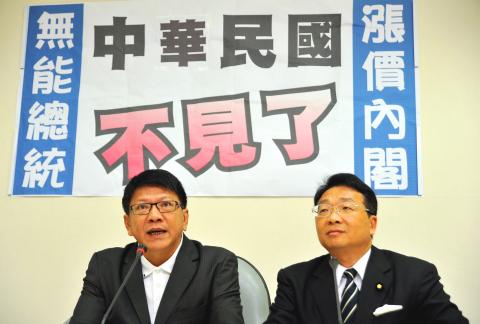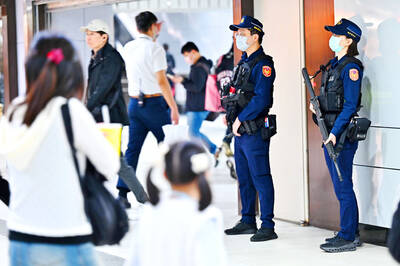The pan-green camp yesterday lashed out at former Chinese Nationalist Party (KMT) chairman Wu Poh-hsiung’s (吳伯雄) “one country, two areas (一國兩區)” comments while meeting Chinese President Hu Jintao (胡錦濤) in Beijing on Thursday, saying it was a virtual elimination of the Republic of China (ROC) and an ill-intentioned step toward unification.
Wu met Hu in Beijing at the annual forum between the KMT and the Chinese Communist Party, during which he proposed that cross-strait matters be tackled using a “one country, two areas” formula.
Taiwan’s current cross-strait policy is based on the Act Governing Relations Between the Peoples of the Taiwan Area and the Mainland Area (台灣地區與大陸地區人民關係條例), which Wu said has “one country, two areas” as its legal basis.

Photo: Chien Jung-fong, Taipei Times
The Democratic Progressive Party (DPP) said the initiative has taken the KMT’s previous position of “one China, with different interpretations” a step further, acknowledging that both sides of the Taiwan Strait belong to “one country.”
“The DPP has always maintained that Taiwan is a sovereign country with the name the Republic of China and that any change in the ‘status quo’ must be decided by the Taiwanese people,” DPP spokesperson Lo Chih-cheng (羅致政) told a press conference.
President Ma Ying-jeou (馬英九), who doubles as KMT chairman, should explain whether he authorized Wu to submit the initiative and whether he agrees with the proposal, Lo said.
The most detrimental impact of was not self-belittlement, but the “implication that both sides of the Taiwan Strait belong to one country, which is an obvious change in the ‘status quo’ and a betrayal of the mainstream of public opinion,” Lo said.
If Wu’s comments represent Ma’s view, “Ma, who has said Taiwan’s future should be determined by its 23 million people, has now formally abandoned and eliminated the ROC and violated his own pledge,” Lo said.
“To say that both sides belong to one country is an ‘overinterpretation’ of the Constitution,” DPP spokesperson Lin Chun-hsien (林俊憲) said. “The description of ‘one country’ would very likely be interpreted by the international community that the ‘country’ refers to the People’s Republic of China [PRC], since the majority of countries recognize the PRC.”
Citing unnamed sources, DPP Legislator Hsueh Ling (薛凌) said Beijing had begun work on a “2012 consensus” that allegedly provides a clearer definition of “one China.”
Beijing would try to turn the “vague” so-called “1992 consensus,” which represents “one China, with different interpretations,” into a new consensus which represents “one China, with an agreed interpretation,” she said.
China would begin to promote the initiative in Taiwan through academics, the media and organizations it privately sponsors, Hsueh said.
“We may accept ‘one system, two countries’ or ‘one area, two countries,’ but we would never accept ‘one country, two areas’ or ‘one country, two systems,’” DPP Legislator Chen Ou-po (陳歐珀) said, adding that Wu may have committed an offense against state security.
The Taiwan Solidarity Union (TSU) described the initiative as “the Treaty of Shimonoseki in the 21st century,” and an act that jeopardizes Taiwan’s sovereignty.
TSU Chairman Huang Kun-huei (黃昆輝), a former Mainland Affairs Council chairman, said the Act Governing Relations Between the Peoples of the Taiwan Area and the Mainland Area had been enacted “with the implication of a state-to-state legal framework.”
The initiative could be part of Ma’s effort to achieve ultimate unification, he said.
“‘One country, two areas’ is exactly the same as ‘one country, two systems’ to the international community,” Huang said.
Ma could have already opened a Pandora’s box, Huang said, because recognition of the “one country” principle “is exactly what Beijing wants.”

TRAGEDY STRIKES TAIPEI: The suspect died after falling off a building after he threw smoke grenades into Taipei Main Station and went on a killing spree in Zhongshan A 27-year-old suspect allegedly threw smoke grenades in Taipei Main Station and then proceeded to Zhongshan MRT Station in a random killing spree that resulted in the death of the suspect and two other civilians, and seven injured, including one in critical condition, as of press time last night. The suspect, identified as a man surnamed Chang Wen (張文), allegedly began the attack at Taipei Main Station, the Taipei Fire Department said, adding that it received a report at 5:24pm that smoke grenades had been thrown in the station. One man in his 50s was rushed to hospital after a cardiac arrest

A car bomb killed a senior Russian general in southern Moscow yesterday morning, the latest high-profile army figure to be blown up in a blast that came just hours after Russian and Ukrainian delegates held separate talks in Miami on a plan to end the war. Kyiv has not commented on the incident, but Russian investigators said they were probing whether the blast was “linked” to “Ukrainian special forces.” The attack was similar to other assassinations of generals and pro-war figures that have either been claimed, or are widely believed to have been orchestrated, by Ukraine. Russian Lieutenant General Fanil Sarvarov, 56, head

SAFETY FIRST: Double the number of police were deployed at the Taipei Marathon, while other cities released plans to bolster public event safety Authorities across Taiwan have stepped up security measures ahead of Christmas and New Year events, following a knife and smoke bomb attack in Taipei on Friday that left four people dead and 11 injured. In a bid to prevent potential copycat incidents, police deployments have been expanded for large gatherings, transport hubs, and other crowded public spaces, according to official statements from police and city authorities. Taipei Mayor Chiang Wan-an (蔣萬安) said the city has “comprehensively raised security readiness” in crowded areas, increased police deployments with armed officers, and intensified patrols during weekends and nighttime hours. For large-scale events, security checkpoints and explosives

PUBLIC SAFETY: The premier said that security would be tightened in transport hubs, while President Lai commended the public for their bravery The government is to deploy more police, including rapid response units, in crowded public areas to ensure a swift response to any threats, President William Lai (賴清德) said yesterday after a knife attack killed three people and injured 11 in Taipei the previous day. Lai made the remarks following a briefing by the National Police Agency on the progress of the investigation, saying that the attack underscored the importance of cooperation in public security between the central and local governments. The attack unfolded in the early evening on Friday around Taipei Main Station’s M7 exit and later near the Taipei MRT’s Zhongshan